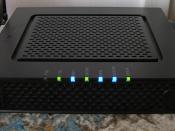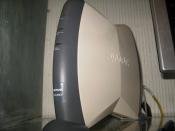SUBJECT: Mechanism Report
WORDS: 663
Cable and DSL Modems
Since the creation of the Internet, home users have always craved power. The only thing available was ISDN and the traditional 56k modem. With the release of cable modems and the discovery of DSL technology, the Internet can be navigated at blazing speeds.
Cable Modem: TYPES
Cable modems were introduced in 1995. There are three types of them, external, internal and interactive setup box. The external modem is a small box that is connected to the computer. The installation of an Ethernet card is required for this type. Since it connects to the computer by a USB port, the installation is very easy.
The second type, internal, is directly inserted into a slot on the motherboard called the PCI bus. This particular modem is only available for PC use and not Macintosh. Upgrades may be needed to synchronize a user's computer.
Some Internet service providers may not support internal modems.
The last type, interactive setup box, relies on the TV to display output. No catches involved with this type.
Figure 1- Cable Modem System
PARTS
A cable modem has a complex process of operation. It is made up of a tuner, demodulator, burst modulator, MAC, interface, and CPU.
TUNER
The tuner plugs directly into the modem. It's responsible for letting signals pass through it. These signals communicate with the PC and the modem itself.
DEMODULATOR
The demodulator analyzes the receiving signals.
BURST MODULATOR
The burst modulator feeds the tuner with signals. Also it decodes information hidden in the signals.
MAC
The MAC is a control mechanism which sits between the transmit and receive paths.
INTERFACE
The interface is simply data coming from a user's PC.
CPU
The user's CPU is used only to assist external cable modems.
DSL: TYPES
DSL has been around since 1998. There 9 types of DSL and some are in production.
VDSL is still in development. It is rumored to be very fast. RADSL is a type, which measures the maximum transfer capability and uses it to operate best on the phone line. SDL receives and sends data at the same rate. IDSL is similar to ISDN, which was very slow. HDSL is used be corporations and can be as fast as a T1 line. G. Lite doesn't require a splitter but is a normal version of DSL. ADSL has a tweaked downstream rate of 6.1 mb/s. This type is not good for the user who wants to send things. CDSL is similar to G. Lite and also requires no splitter
Figure 2- ADSL Transmission
FEATURES
With all the types of DSL there are a wide range of features. One of the most popular is the ability to talk while signed online. All types of speed packages are available. It all depends on which type of DSL you choose.
CONCLUSION:
Cable modems link to the computer via Ethernet, which makes the service online all the time. However, Ethernet is a shared medium, and the speed will vary depending on how many customers on that cable segment are using the Web at the same time. Just like a cable modem, DSL provides "always-on" operation, which is great because your phone lines are free and there's no dial-up. DSL being a new technology is very much advanced, that's why special representatives are needed to handle problems or installation. If a user lives far away from the station the service will be poor unlike someone who lives closer. The representatives might need to fix your wiring up also. That and the speed is pretty much the difference between cable modems and DSL modems. Another negative thing about cable modems are some cable operators are strict about running a server. The purchase of an Ethernet card is required as well. Internal modems can't be used with Macintosh; also expensive upgrades may be required. Some areas don't even offer service, which goes for the DSL service also.



Nice technical description
I vaguely understood the difference of modems before I read this. I knew already that my 56K really sucked, but after this i have a better handle on the broadband modems and their functionality.
0 out of 0 people found this comment useful.